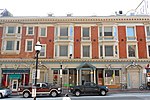Commercial Credit Company Building

The Commercial Credit Company Building, also known as The Residences at 300 St. Paul, is a historic building located in Baltimore, Maryland, United States. It is significant as the first post-World War II office building constructed in the city, its associations with the Commercial Credit Company who commissioned it, and the New York City architectural firm Harrison and Abramovitz who designed it.Construction on the Modernist structure began in 1954 and it was completed three years later. Edwards and Hjorth were the general contractors. The property is located on a steep slope. The eastern section of the building is 19-stories, with a five-story section in the middle and a two-story section on its west elevation. The base of the building is composed of a Deer Isle granite with a glazed aluminum curtain wall in the center. The upper floors are slightly recessed from the base and are clad in grey aluminum panels. Commercial Credit Company continued to own the building until 1989. It has subsequently been converted into apartments. The building was listed on the National Register of Historic Places in 2018.
Excerpt from the Wikipedia article Commercial Credit Company Building (License: CC BY-SA 3.0, Authors, Images).Commercial Credit Company Building
Saint Paul Place, Baltimore Downtown
Geographical coordinates (GPS) Address Nearby Places Show on map
Geographical coordinates (GPS)
| Latitude | Longitude |
|---|---|
| N 39.292777777778 ° | E -76.614166666667 ° |
Address
The Residences at 300 Saint Paul Place
Saint Paul Place 300
21202 Baltimore, Downtown
Maryland, United States
Open on Google Maps









